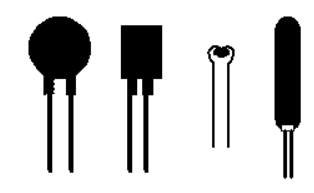The great advantage of thermistor is its high sensitivity. They are mainly used for room temperature measurements up to moderate high temperatures. They are popular in research and medical applications, such as electronic medical thermometers.
Thermistor is a kind of thermistor whose resistance varies with temperature. Resistance is measured by passing a small measuring direct current (DC) through it and measuring the resulting voltage drop.
There are two basic types of thermistors, PTC and NTC:
PTC (positive temperature coefficient) devices show an increase in resistance as the temperature increases. PTC thermistor is a temperature dependent resistor made of barium titanate. It should be selected when the resistance needs to be greatly changed at a specific temperature or current level.
The NTC (negative temperature coefficient) device shows a decrease in resistance as the temperature increases. NTC thermistors are made up of semiconductors. They are made from a mixture of oxides of manganese, cobalt, copper or nickel. Their operating temperature ranges from – 150 ° C to 600 ° C. For a temperature of about 700 ℃, devices using zirconia doped with rare earth oxides can be used. NTC should be selected when it is necessary to change the resistance continuously in a wide temperature range. They have mechanical, thermal and electrical stability as well as high sensitivity.
Thermistors are commercially available in various shapes: beads, discs, chips and probes. The most common form is a bead with two wires attached. The bead diameter can be about 0.5mm to 5mm.

Small size thermistors make them very adaptable and are usually included in electronic circuits. They can be encapsulated in epoxy or glass or painted. Thermistors are simple, robust and very reliable
Temperature dependence of resistance
The resistance of CTN thermistor decreases exponentially with the increase of temperature. It is negative and nonlinear, as shown by the following relation:
Where R 0 is the nominal resistance measured at the absolute temperature t0 (usually measured at 25 ° C) and B is the constant of the specific thermistor material. The nonlinear characteristics of resistors may be undesirable, and this can be offset by using two or more thermistors in series or in parallel, packaged in a single device.
The temperature coefficient of resistance α, expressed in% / K (or% / ° C), is defined as follows:
The coefficient α of PTC thermistor is positive, while that of NTC thermistor is negative.
The Steinhart & Hart equation can be used to determine the temperature from the thermistor:
Where R is the thermistor in ohm, t is the absolute temperature, K, a, B and C are constants, which are usually provided by the manufacturer, but can be determined by calibrating at three different temperatures and solving three simultaneous equations.
This equation is very close to the actual device, but it does not always provide the required accuracy over the entire temperature range. This can be corrected by fitting the Steinhart & Hart equations over a range of narrow temperature ranges and then “stitching” them together to cover the desired range.
Advantages and disadvantages of thermistor
The great advantage of thermistors is that they can be point measured
Compared with other temperature sensors, their high sensitivity allows thermistors to operate in a small temperature range and are very accurate (usually better than 0.05 ° C and 0.1 ° C). The sensitivity of thermistor can be one order of magnitude higher than that of resistance thermometer (RTD)
The most common temperature range is 0 ° C to 100 ° C. At higher temperatures, they drift greatly
The high resistivity of thermistors eliminates the need for a four wire bridge circuit
Thermistors are very nonlinear and not robust, which limits their application
The error source is due to the self heating effect caused by excessive bias current when the thermistor is powered on to provide the output voltage signal. In order to reduce this source of error, a current suitable for measuring resistance must be used.
Due to its performance and moderate cost, thermistors are suitable for temperature measurement and control, temperature compensation, electronics, medical and many other applications.